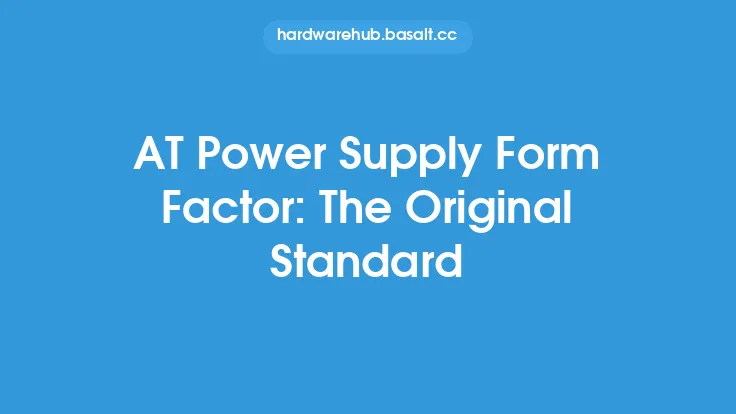The BTX (Balanced Technology eXtended) power supply form factor is a standard for power supplies that was introduced by Intel in 2004. It was designed to provide a more efficient and reliable power delivery system for computers, particularly for high-performance systems that require a lot of power. The BTX form factor is an alternative to the traditional ATX (Advanced Technology eXtended) form factor, which has been the dominant standard for power supplies in the computer industry for many years.
Introduction to BTX Power Supply Form Factor
The BTX power supply form factor is designed to provide a number of benefits over traditional ATX power supplies. One of the main advantages of BTX power supplies is their ability to provide more power to the system while generating less heat. This is achieved through the use of a more efficient design that allows for better airflow and heat dissipation. BTX power supplies also have a number of other features that make them more reliable and efficient, such as improved voltage regulation and reduced electromagnetic interference (EMI).
Key Features of BTX Power Supply Form Factor
BTX power supplies have a number of key features that distinguish them from traditional ATX power supplies. One of the main features of BTX power supplies is their use of a 24-pin main power connector, which provides more power to the system than the traditional 20-pin connector used in ATX power supplies. BTX power supplies also have a number of other connectors, including an 8-pin auxiliary power connector and a 6-pin PCIe power connector. These connectors provide power to the system's components, such as the CPU, motherboard, and graphics cards.
Technical Specifications of BTX Power Supply Form Factor
The technical specifications of BTX power supplies are similar to those of traditional ATX power supplies, but with a few key differences. BTX power supplies are designed to provide a maximum power output of 650 watts, which is higher than the maximum power output of traditional ATX power supplies. BTX power supplies also have a higher efficiency rating than traditional ATX power supplies, with a minimum efficiency rating of 80%. This means that BTX power supplies are able to convert more of the input power into usable power, which reduces waste heat and improves overall system reliability.
Benefits of BTX Power Supply Form Factor
The BTX power supply form factor has a number of benefits that make it an attractive option for system builders. One of the main benefits of BTX power supplies is their ability to provide more power to the system while generating less heat. This makes them ideal for high-performance systems that require a lot of power, such as gaming systems and workstations. BTX power supplies are also more reliable and efficient than traditional ATX power supplies, which makes them a good option for systems that require high uptime and low maintenance.
Comparison with Other Power Supply Form Factors
The BTX power supply form factor is one of several power supply form factors that are available on the market. Other popular power supply form factors include ATX, Micro-ATX, and Mini-ITX. Each of these form factors has its own strengths and weaknesses, and the choice of which one to use will depend on the specific needs of the system. BTX power supplies are generally more expensive than traditional ATX power supplies, but they offer a number of benefits that make them worth the extra cost. They are also more efficient and reliable than traditional ATX power supplies, which makes them a good option for systems that require high uptime and low maintenance.
Conclusion
In conclusion, the BTX power supply form factor is a standard for power supplies that was introduced by Intel in 2004. It is designed to provide a more efficient and reliable power delivery system for computers, particularly for high-performance systems that require a lot of power. BTX power supplies have a number of benefits, including improved voltage regulation, reduced electromagnetic interference, and increased efficiency. They are also more reliable and efficient than traditional ATX power supplies, which makes them a good option for systems that require high uptime and low maintenance. While BTX power supplies are generally more expensive than traditional ATX power supplies, they offer a number of benefits that make them worth the extra cost.





